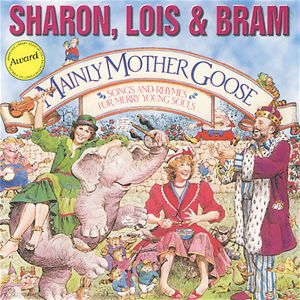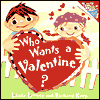 Early Literacy Aside--Explain: Researchers have found that children with a large vocabulary, who have heard a lot of different words, find it easier to learn to read when the time comes.Read Who Wants a Valentine?
Early Literacy Aside--Example: Don't replace unfamiliar words, use them and explain them if necessary. For example: "Tea for two?/ I decline./ I don't want a valentine." I didn't change the word decline, I explained it: decline means to say no.
Early Literacy Aside--Explain: Researchers have found that children with a large vocabulary, who have heard a lot of different words, find it easier to learn to read when the time comes.Read Who Wants a Valentine?
Early Literacy Aside--Example: Don't replace unfamiliar words, use them and explain them if necessary. For example: "Tea for two?/ I decline./ I don't want a valentine." I didn't change the word decline, I explained it: decline means to say no.
Submitted by Megan Brandmaier, Cincinnati (OH) Public Library

 Submitted by Anna Hancock, Cincinnati (OH) Public Library
Submitted by Anna Hancock, Cincinnati (OH) Public Library [New words in this book: activities, camera lens, grinning, waddle, amazing, developed]Listen to the interesting words in this book as I read it.
Read the book.
Early Literacy Aside--Example: Hearing new words in books helps your child learn lots of words and the more vocabulary they learn the more they will understand what they will read.
[New words in this book: activities, camera lens, grinning, waddle, amazing, developed]Listen to the interesting words in this book as I read it.
Read the book.
Early Literacy Aside--Example: Hearing new words in books helps your child learn lots of words and the more vocabulary they learn the more they will understand what they will read. Before reading the book: Ask the children to describe things they would put in a box. And in this box it will contain art supplies. What can you think of? They reply with crayons, paint, etc. This is a great way for children to use the vocabulary that they do know and also good for developing Narrative Skills, which is the ability to describe events and tell stories. Now let's see how a book can help introduce children to new vocabulary.Read the book Art Box by Gail Gibbons.
Have items like compass, protractor, etc. available for the children to see and use. Talk about what they do.
Early Literacy Aside--Empower: Parents, having real objects to help children understand words in the book is one way to help build their vocabulary, to learn the meanings of words. Even when you are not reading books, just talking about objects around the house and what they do is one way to expand children's understanding.
Before reading the book: Ask the children to describe things they would put in a box. And in this box it will contain art supplies. What can you think of? They reply with crayons, paint, etc. This is a great way for children to use the vocabulary that they do know and also good for developing Narrative Skills, which is the ability to describe events and tell stories. Now let's see how a book can help introduce children to new vocabulary.Read the book Art Box by Gail Gibbons.
Have items like compass, protractor, etc. available for the children to see and use. Talk about what they do.
Early Literacy Aside--Empower: Parents, having real objects to help children understand words in the book is one way to help build their vocabulary, to learn the meanings of words. Even when you are not reading books, just talking about objects around the house and what they do is one way to expand children's understanding.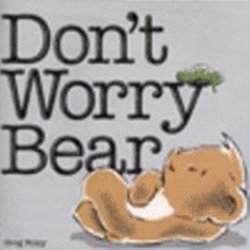
 Early Literacy Aside--Explain: Today I'll be pointing out some activities we are doing that support ealry literacy in the area of vocabulary. This is the term that researchers give to knowing the meanings of words. You can see what we do here in storytime and you may get some ideas of what you can do with your children throughout the day.Read the book Who Is Driving? by Leo Timmers. Pause occasionally to talk about a picture and ask what they see in the picture. Add a word or two, synonyms to the words in the the book, the children might not know.
Early Literacy Aside--Example: As you can see, I don't just read the book. We talk about the pictures and ask questions. Allow time for your child to say something back, even if you don't understant exactly what they say. You can see I added in a couple of unfamiliar words too.
Early Literacy Aside--Empower: Our youngest children learn words that name things they can see (pig, tractor, hippopotamus). As children get older they understand words for feelings and concepts, and older still, they understand words for ideas. It is good to expose even young children to all kinds of words, but they will understand the words for things they can see first.
Early Literacy Aside--Explain: Today I'll be pointing out some activities we are doing that support ealry literacy in the area of vocabulary. This is the term that researchers give to knowing the meanings of words. You can see what we do here in storytime and you may get some ideas of what you can do with your children throughout the day.Read the book Who Is Driving? by Leo Timmers. Pause occasionally to talk about a picture and ask what they see in the picture. Add a word or two, synonyms to the words in the the book, the children might not know.
Early Literacy Aside--Example: As you can see, I don't just read the book. We talk about the pictures and ask questions. Allow time for your child to say something back, even if you don't understant exactly what they say. You can see I added in a couple of unfamiliar words too.
Early Literacy Aside--Empower: Our youngest children learn words that name things they can see (pig, tractor, hippopotamus). As children get older they understand words for feelings and concepts, and older still, they understand words for ideas. It is good to expose even young children to all kinds of words, but they will understand the words for things they can see first. Aside: As your baby begins to talk, respond by elaborating on what he says. For example, if your baby points to a picture and says "cat" respond by saying, "Yes, that's a little cat with orange fur." Talking about the picture even if your baby doesn't understand everything also helps build your child's vocabulary. For example, you could say, "Look, the two kittens are playing with the string. They are having fun together."Submitted by Cindy Christin, Bozeman (MT) Public Library
Aside: As your baby begins to talk, respond by elaborating on what he says. For example, if your baby points to a picture and says "cat" respond by saying, "Yes, that's a little cat with orange fur." Talking about the picture even if your baby doesn't understand everything also helps build your child's vocabulary. For example, you could say, "Look, the two kittens are playing with the string. They are having fun together."Submitted by Cindy Christin, Bozeman (MT) Public Library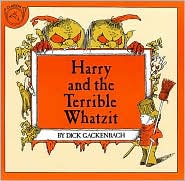 Early Literacy Aside--Explain: Today we are going to focus on vocabulary, one of the early literacy skills. Vocabulary is knowing the meanings of words, of things, concepts, feelings and ideas.Book Introduction: Talk about the word cellar. What is a cellar? Explain the word.
Read the book Harry and the Terrible Whatzit by Dick Gackenbach.
Early Literacy Aside--Example: Go ahead and use words that are unfamiliar to your child. Don't replace words in books that they may not understand, but explain them. This will build their vocabulary.
Early Literacy Aside--Empower: Don't forget when reading to your children at home, don't replace words, but explain them. This helps build their vocabulary and will make it easier for your children to later understand what they read.
Submitted by Janet Boucher, Blue Ridge (VA) Regional Library
Early Literacy Aside--Explain: Today we are going to focus on vocabulary, one of the early literacy skills. Vocabulary is knowing the meanings of words, of things, concepts, feelings and ideas.Book Introduction: Talk about the word cellar. What is a cellar? Explain the word.
Read the book Harry and the Terrible Whatzit by Dick Gackenbach.
Early Literacy Aside--Example: Go ahead and use words that are unfamiliar to your child. Don't replace words in books that they may not understand, but explain them. This will build their vocabulary.
Early Literacy Aside--Empower: Don't forget when reading to your children at home, don't replace words, but explain them. This helps build their vocabulary and will make it easier for your children to later understand what they read.
Submitted by Janet Boucher, Blue Ridge (VA) Regional Library As you read the book, ask the children to identify the animals in the book. Talk about the landscape in the pictures--where in the world might this take place? Use words the children may not know (arctic, icebergs, ice floes, glaciers, etc.). Also, talk about Tacky the Penguin's personality, his uniqueness and originality, explaining words children may not know. For an activity, have children and adults draw and color a penguin however they want.Early Literacy Aside--Empower: We used lots of interesting words today with Tacky the Penquin, some were not even in the book. This helps develop your child's vocabulary. On your way home, talk about being creative and ways your child is unique, using some of the interesting words we used today and adding your own. Through talking and talking about your children's drawings there are many opportunities to expand your child's vocabulary.
As you read the book, ask the children to identify the animals in the book. Talk about the landscape in the pictures--where in the world might this take place? Use words the children may not know (arctic, icebergs, ice floes, glaciers, etc.). Also, talk about Tacky the Penguin's personality, his uniqueness and originality, explaining words children may not know. For an activity, have children and adults draw and color a penguin however they want.Early Literacy Aside--Empower: We used lots of interesting words today with Tacky the Penquin, some were not even in the book. This helps develop your child's vocabulary. On your way home, talk about being creative and ways your child is unique, using some of the interesting words we used today and adding your own. Through talking and talking about your children's drawings there are many opportunities to expand your child's vocabulary. Early Literacy Aside--Explain: Vocabulary is a very important early literacy skill. By vocabulary, I mean knowing the meanings of words. Today we're focusing on the concept of opposites.
Read the book Maisy Big, Maisy Small by Lucy Cousins with time to allow participants to respond with the opposite word. [Add a synonym for a couple of the words as well. If a participant gives a different word for the opposite word, comment on it. For example if you say big and the book says small, but a child says tiny, you can note that tiny and small have similar meanings and both are the opposite of big.]
Early Literacy Aside--Example: Using this book your children filled in the word meaning the opposite of the one I said from the book. You can always add more interesting words for both the opposite and synonyms for some words. In this way you build your children's vocabulary.
Early Litearcy Aside--Empower: Today in storytime we talked about opposites. As you go about your day, when talking about feelings (hungry, full, tired, wide awake), about what you are doing (relaxing, hurrying, walking slowly, running quickly), or playing, there are many opportunities to think of opposites which builds your children's vocabulary. These little things you do throughout the day will later help them understand what they read.
Early Literacy Aside--Explain: Vocabulary is a very important early literacy skill. By vocabulary, I mean knowing the meanings of words. Today we're focusing on the concept of opposites.
Read the book Maisy Big, Maisy Small by Lucy Cousins with time to allow participants to respond with the opposite word. [Add a synonym for a couple of the words as well. If a participant gives a different word for the opposite word, comment on it. For example if you say big and the book says small, but a child says tiny, you can note that tiny and small have similar meanings and both are the opposite of big.]
Early Literacy Aside--Example: Using this book your children filled in the word meaning the opposite of the one I said from the book. You can always add more interesting words for both the opposite and synonyms for some words. In this way you build your children's vocabulary.
Early Litearcy Aside--Empower: Today in storytime we talked about opposites. As you go about your day, when talking about feelings (hungry, full, tired, wide awake), about what you are doing (relaxing, hurrying, walking slowly, running quickly), or playing, there are many opportunities to think of opposites which builds your children's vocabulary. These little things you do throughout the day will later help them understand what they read.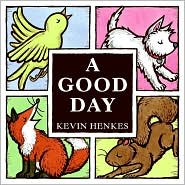 Book Introduction: In this book there are four animals (point to them on the cover)--a yellow bird, a white dog, an orange fox, and a brown squirrel. For each animal something sad happens, but then something good does, too! Let's see what happens.Read the book A Good Day by Kevin Henkes.
Sometimes something happens to us that makes us sad, but then we find a way to be happier. I am going to give each person a piece of paper and there are some crayons to share. I would like you to draw a picture of a time you were sad and a time you could make yourself happy. Then tell me or the adult who brought you about your picture.
Early Literacy Aside--Example: Adults, having your child describe their experiences and feelings aloud gives you an opportunity to develop their vocabulary and background knowledge. You can add more words to what they already use and also explain more about the situations they describe.
Book Introduction: In this book there are four animals (point to them on the cover)--a yellow bird, a white dog, an orange fox, and a brown squirrel. For each animal something sad happens, but then something good does, too! Let's see what happens.Read the book A Good Day by Kevin Henkes.
Sometimes something happens to us that makes us sad, but then we find a way to be happier. I am going to give each person a piece of paper and there are some crayons to share. I would like you to draw a picture of a time you were sad and a time you could make yourself happy. Then tell me or the adult who brought you about your picture.
Early Literacy Aside--Example: Adults, having your child describe their experiences and feelings aloud gives you an opportunity to develop their vocabulary and background knowledge. You can add more words to what they already use and also explain more about the situations they describe. Book Introduction: Our next book is on trains and it has some words that are opposites. For example, the opposite of happy is . . . sad, that's right! The opposite of hot is . . . cold, right! As you listen to this book see if you notice words that are opposites.Read the book A Train Goes Clickety-Clack by Jonathan London all the way through. Then come back to the pages that have opposites (old, new; fast, slow; up, down). Read one set and ask, whatis the opposite of old? NEW! and so forth.
Early Literacy Aside--Example: Adults, talking about not only words but their relationships, like opposites, helps develop your child's vocabulary.
Book Introduction: Our next book is on trains and it has some words that are opposites. For example, the opposite of happy is . . . sad, that's right! The opposite of hot is . . . cold, right! As you listen to this book see if you notice words that are opposites.Read the book A Train Goes Clickety-Clack by Jonathan London all the way through. Then come back to the pages that have opposites (old, new; fast, slow; up, down). Read one set and ask, whatis the opposite of old? NEW! and so forth.
Early Literacy Aside--Example: Adults, talking about not only words but their relationships, like opposites, helps develop your child's vocabulary.